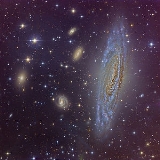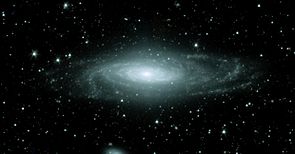
NGC 7331
Encyclopedia
NGC 7331 is a spiral galaxy
about 40 Mly away in the constellation
Pegasus
. It was discovered by William Herschel
in 1784. NGC 7331 is the brightest member of the NGC 7331 Group of galaxies.
The galaxy is similar in size and structure to the galaxy we inhabit, and is often referred to as "the Milky Way
's twin", although recent discoveries regarding the structure of the Milky Way may call this similarity into doubt.
to the rest of the disk. The current bulge may have formed from infalling material, however if it has been there since the formation of the galaxy then it would be difficult to explain how such a situation arose.

, is the only supernova that has been identified within NGC 7331. The supernova was discovered by Milton Humason and H. S. Gates in a survey at Palomar Observatory
.
Spiral galaxy
A spiral galaxy is a certain kind of galaxy originally described by Edwin Hubble in his 1936 work The Realm of the Nebulae and, as such, forms part of the Hubble sequence. Spiral galaxies consist of a flat, rotating disk containing stars, gas and dust, and a central concentration of stars known as...
about 40 Mly away in the constellation
Constellation
In modern astronomy, a constellation is an internationally defined area of the celestial sphere. These areas are grouped around asterisms, patterns formed by prominent stars within apparent proximity to one another on Earth's night sky....
Pegasus
Pegasus (constellation)
Pegasus is a constellation in the northern sky, named after the winged horse Pegasus in Greek mythology. It was one of the 48 constellations listed by the 2nd century astronomer Ptolemy, and remains one of the 88 modern constellations.-Stars:...
. It was discovered by William Herschel
William Herschel
Sir Frederick William Herschel, KH, FRS, German: Friedrich Wilhelm Herschel was a German-born British astronomer, technical expert, and composer. Born in Hanover, Wilhelm first followed his father into the Military Band of Hanover, but emigrated to Britain at age 19...
in 1784. NGC 7331 is the brightest member of the NGC 7331 Group of galaxies.
The galaxy is similar in size and structure to the galaxy we inhabit, and is often referred to as "the Milky Way
Milky Way
The Milky Way is the galaxy that contains the Solar System. This name derives from its appearance as a dim un-resolved "milky" glowing band arching across the night sky...
's twin", although recent discoveries regarding the structure of the Milky Way may call this similarity into doubt.
Retrograde bulge
In spiral galaxies the central bulge typically co-rotates with the disk but the bulge in the galaxy NGC 7331 is rotating in the opposite directionRetrograde motion
Retrograde motion is motion in the direction opposite to the movement of something else, and is the contrary of direct or prograde motion. This motion can be the orbit of one body about another body or about some other point, or the rotation of a single body about its axis, or other phenomena such...
to the rest of the disk. The current bulge may have formed from infalling material, however if it has been there since the formation of the galaxy then it would be difficult to explain how such a situation arose.

Supernova
SN 1959D, a Type IIL supernovaSupernova
A supernova is a stellar explosion that is more energetic than a nova. It is pronounced with the plural supernovae or supernovas. Supernovae are extremely luminous and cause a burst of radiation that often briefly outshines an entire galaxy, before fading from view over several weeks or months...
, is the only supernova that has been identified within NGC 7331. The supernova was discovered by Milton Humason and H. S. Gates in a survey at Palomar Observatory
Palomar Observatory
Palomar Observatory is a privately owned observatory located in San Diego County, California, southeast of Pasadena's Mount Wilson Observatory, in the Palomar Mountain Range. At approximately elevation, it is owned and operated by the California Institute of Technology...
.
See also
- M94Messier 94Messier 94 is a spiral galaxy in the constellation Canes Venatici. It was discovered by Pierre Méchain in 1781,...
– another galaxy with a prominent starburst ring - NGC 1512NGC 1512NGC 1512 is a barred spiral galaxy approximately 30 million light-years away from Earth in the constellation Horologium. It is a member of the Dorado Group.-External links:* *...
– another galaxy with a prominent starburst ring
External links
- Calar Alto Observatory – NGC 7331
- APOD (2004-07-01) – "A Galaxy So Inclined"
- SST – "Morphology of Our Galaxy's 'Twin'"
- NGC 7331 at the astro-photography site of Mr. T. Yoshida
- NGC7331 at W. Kloehr Astrophotography

